
Death and bereavement are profound aspects of the human experience that confront us with the fragility of life and the complexity of our emotions. In times of loss, turning to our cultural and religious traditions can provide solace, support, and a deeper sense of meaning. For those in the Sephardic Jewish community, Judaism is more than just a religion—it is a way of life woven into the fabric of their identity, values, and daily practices.
Embracing Sephardic Jewish Mourning Practices
In this comprehensive guide, we embark on a journey through the mourning process from a Sephardic perspective. We explore the rich tapestry of customs, rituals, and traditions that offer guidance and comfort during times of death and loss. Rooted in a deep appreciation for the beauty of Judaism, this guide seeks to illuminate the unique aspects of Sephardic Jewish mourning practices, providing insights, guidance, and practical advice to navigate the complexities of grief and honor the memory of loved ones.
The Significance of Judaism in the Face of Death
Judaism, with its rich history and deep spiritual foundation, encompasses more than a set of religious beliefs. It is a way of life that permeates every aspect of existence, providing a framework for personal and communal growth, ethical living, and the cultivation of deep connections with one another and the divine. Sephardic Jews, with their diverse cultural heritage and unique traditions, bring their own distinct perspectives to the mourning process, offering a tapestry of rituals and practices that weave together elements of faith, family, and community.
Exploring the Pillars of Sephardic Jewish Mourning Practices
Throughout this guide, we will explore five essential chapters that form the pillars of Sephardic Jewish mourning practices. From the initial phase of Aninut, marked by sacred rituals and the support of the Chevra Kadisha, to the deeply meaningful customs observed during Shiva, Sheloshim, Avelut, and Azkara, we will delve into the emotional, spiritual, and communal dimensions of death and mourning. Each chapter offers insights into the unique customs, practical considerations, and profound rituals that guide individuals and families through the process of grief and remembrance.
Chapter 1: Aninut – The Sacred Phase Between Death and Burial
In this chapter, we delve into the sacred period of Aninut, which encompasses the time between death and burial. We explore the emotional and spiritual impact of this phase and the customs and rituals observed by Sephardic Jews during this sensitive time of death. The involvement of the Chevra Kadisha, or Burial Society, is highlighted, emphasizing their sacred duty to prepare the body for burial with utmost respect and dignity. We discuss the significance of tahara, the ritual purification of the deceased, and the Sephardic customs that prioritize simplicity and modesty in funeral arrangements. Additionally, we explore the communal act of participating in the burial process by placing dirt into the grave, symbolizing a final act of respect and farewell to the departed.
Chapter 2: Shiva – Embracing Solace and Support During the Mourning Period
During the Shiva period, mourners enter a time of deep reflection and communal support. We explore the customs and practices observed during this week-long period, focusing on the Sephardic perspective. Keriah, the tearing of clothing, is discussed as a powerful act of mourning that expresses the depth of grief. The ritual of washing hands upon returning to the Shiva house is explored, highlighting its symbolic significance. The meal of condolences, known as Seudat Havra’ah, is discussed as a meaningful gathering where nourishment and comfort are shared. The lighting of candles, covering of mirrors, and displaying of pictures are explored as practices that create a sacred and reflective space for mourning.
Chapter 3: Sheloshim – Healing and Reflection in the Thirty-Day Mourning Period
In the Sheloshim period, which spans thirty days, mourners continue their journey of healing and reflection. We delve into the customs and practices observed during this phase, offering insights into the Sephardic approach. The significance of refraining from joyful activities, such as attending celebrations and wearing new clothing, is discussed as a means of honoring the memory of the departed and focusing on the mourning process. We explore the practice of daily prayer and study, known as “Avelut d’Devarim,” which allows mourners to engage in spiritual reflection and find solace in their faith. Additionally, we discuss the importance of supporting the mourners through acts of kindness and communal gatherings, providing comfort and understanding during this extended period of mourning.
Chapter 4: Avelut – Mourning Practices and Observances
In the chapter on Avelut, we explore the mourning practices and observances that extend beyond the Sheloshim period. We delve into the profound impact of Avelut on the lives of mourners and the community as a whole. The significance of refraining from certain activities, such as attending festive gatherings and engaging in personal celebrations, is discussed as a way to honor the memory of the departed and maintain a focus on mourning. We explore the concept of Kaddish, a prayer recited by mourners to elevate the souls of the departed, and the unique customs and variations within the Sephardic tradition. Additionally, we delve into the practice of Azkara, a memorial prayer recited on specific occasions, as a way to remember and honor loved ones who have passed away.
Chapter 5: Azkara – Commemorating the Anniversary of the Passing
In the final chapter, we explore the practice of Azkara, which involves commemorating the anniversary of the passing of a loved one. We delve into the customs and rituals observed during this important milestone, reflecting on the enduring impact of the departed’s life. We discuss the significance of visiting the gravesite and reciting prayers in remembrance. The practice of giving tzedakah (charitable donations) in honor of the departed is explored as a meaningful way to continue their legacy of kindness and compassion. We also discuss the role of community support during this time, as friends and family gather to offer comfort and share memories, reaffirming the connection between the living and the deceased.
Conclusion – Sephardic Jewish Mourning Practices
In this comprehensive guide to death and bereavement from a Sephardic perspective, we have explored the profound customs, rituals, and traditions that guide individuals and families through the mourning process. From the sacred phase of Aninut to the periods of Shiva, Sheloshim, Avelut, and the commemoration of Azkara, we have delved into the emotional, spiritual, and communal dimensions of death and mourning.
Sephardic Jewish mourning practices provide a framework of support, solace, and remembrance, allowing mourners to navigate the complexities of grief with reverence and strength. By honoring the memory of loved ones and drawing upon the wisdom of our traditions, we find comfort, healing, and a deeper connection to our faith and community.
May this guide serve as a source of guidance and comfort for those who mourn, reminding us of the beauty and resilience of the human spirit in times of loss. As we journey through the mourning process, may we find solace in the traditions and customs that bind us together as a community, offering support, understanding, and a profound sense of connection.
Let’s get started.









